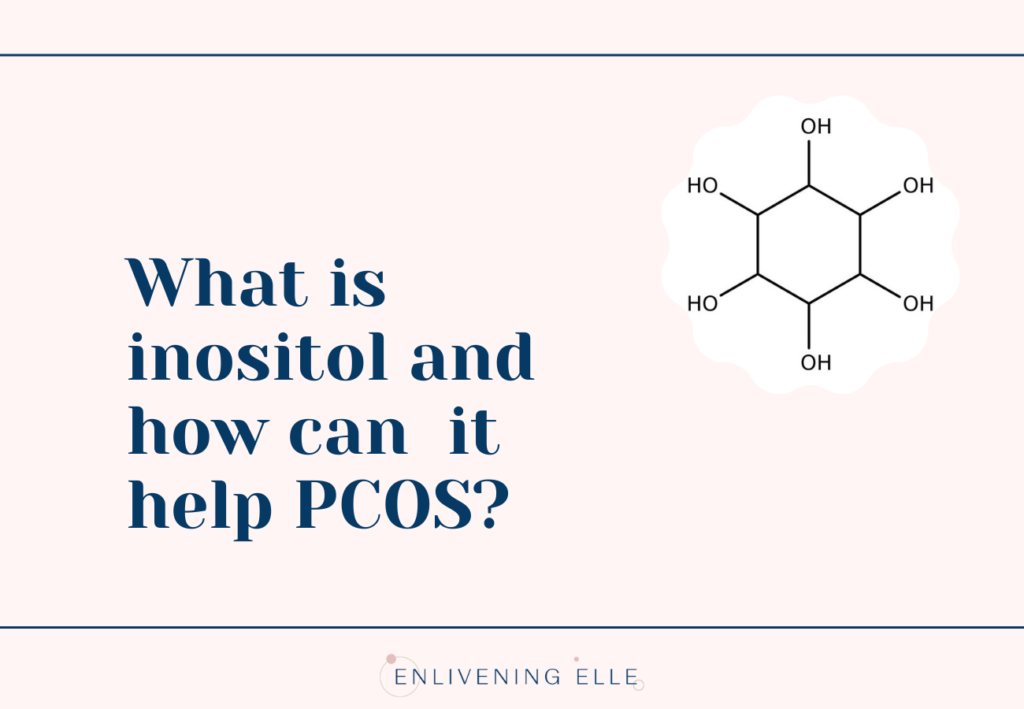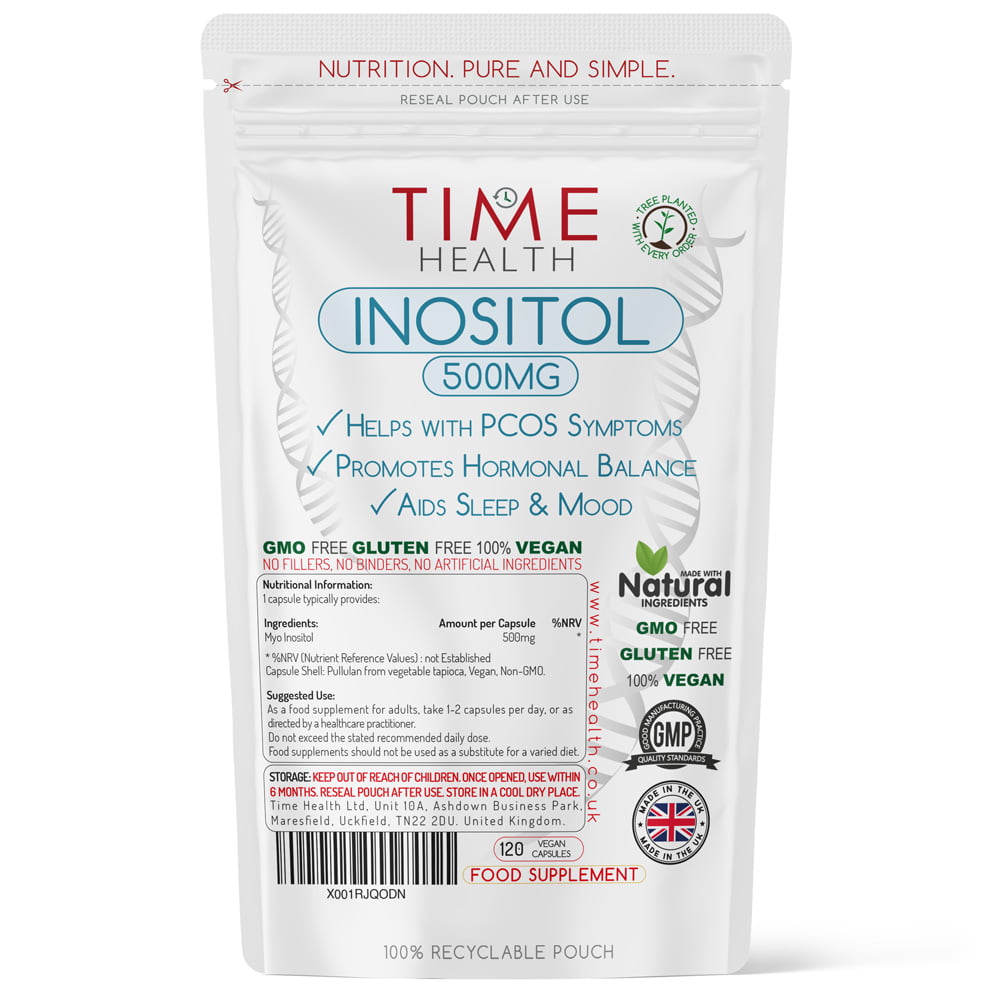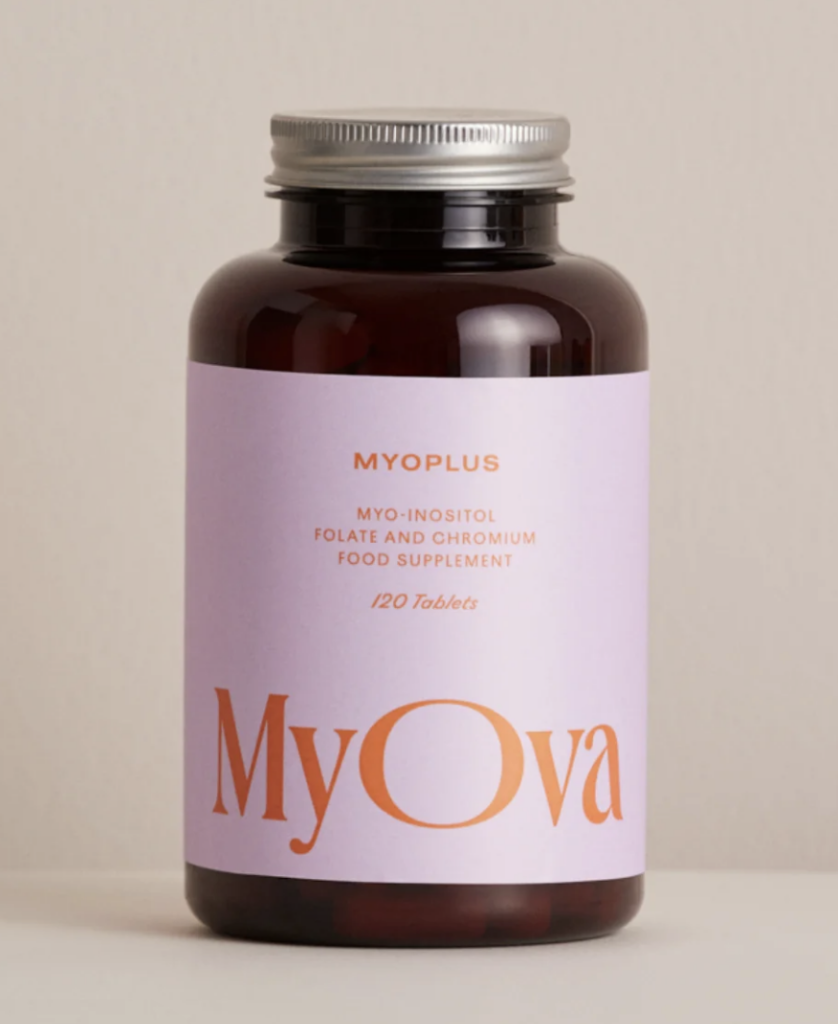Inositol and PCOS: how does it help?

Inositol and PCOS
When looking at supplements for polycycstic ovary syndrome (PCOS), inositol is one that often recommended. Inositol may help to reduce insulin resistance and hyperandrogegism as well as improving egg quality and ovulation [1, 2, 3]. Myo-inositol may help to improve FSH/LH cholesterol ratio and support menstrual cycle regularity. But what is inositol, and can it truly be beneficial for people with PCOS?
What is inositol?
Inositols used to be thought of as B-vitamins, but are a group of alcohol sugars and can be synthesised in the body from glucose. There are 9 forms or “isomers” of inositol, of which myo-insositol is the most chemically stable. This means it is less likely to react with other molecules or change form. Myo-inositol is the most commonly used form of inositol in the body. Because of the different structures of these different inositols, each has a slightly different role in the body. Myo-inositol and D-chiro-inositol are the two types that have the most research and evidence behind them for supporting PCOS.
How does inositol help blood sugar?
Inositol acts as a secondary messenger. Secondary messengers are intracellular signalling molecules that help to facilitate processes within and between cells. One of the roles of inositol as a secondary messenger is to help the hormone insulin to drive glucose uptake in cells. There’s a useful analogy that can help to demonstrate this relationship:
Think of glucose as someone trying to get through a door into an exclusive club, with the club representing a cell in your body. Insulin acts as a security guard in charge of letting the glucose through the door into the club at the right time. Inositol’s job is a bit like WD40, as it helps to loosen the hinges on the door so that it opens smoothly to help insulin do its job properly.
Myo-inositol or D-chiro-inositol and PCOS
Some myo-inositol is converted to D-chiro-inositol by a specific enzyme called epimerase. The activity of this epimerase is insulin dependent. This means the enzyme requires insulin to work, and the amount of insulin impacts how much myo-inositol is converted to D-chiro-inositol. Only a small quantity of myo-inositol is converted into D-chiro-inositol and the conversion is irreversible. D-chrio-inositol can’t be changed back to myo-inositol.
Part of the role of myo-inositol as a secondary messenger is to mediate glucose uptake and follicle-stimulating hormone (FSH) signalling. D-chiro-inositol supports glucose storage and is involved in synthesis of androgens (“male” hormones) [4].
How does inositol help PCOS
The conversion of myo– to D-chiro-inositol is impacted by insulin levels. Women with PCOS are more likely to have high insulin levels, and so inositol levels can look different in women with PCOS compared to those without.
If levels of insulin are high, the activity of the enzyme epimerase is increased. Because of this, higher amounts of myo-inositol is converted into D-chiro-inositol. This reduces the amount of myo-insotiol. This impacts the signalling of FSH, and so disrupts the normal balance of reproductive hormones [5].
Most evidence recommends a 40:1 ratio of myo- to D-chiro inositol to support management of PCOS symptoms [6]. This ratio may help to correct the altered ratio of myo– to D-chiro-inositol. A small study also showed that 40:1 inositol may support pregnancy outcomes in women without insulin resistance [7].
Should I supplement inositol for PCOS
Inositol has shown promise in improving insulin sensitivity, reducing androgen levels, and promoting regular menstrual cycles. Although there is potential evidence for inositol in PCOS management, it does not have a guaranteed effect. Speaking to a healthcare professional may help you to decide if it is the right supplement for you, or try taking it for 3-6 months to see if it improves symptoms.
Inositol
The following products contain affiliate links, which mean we may receive a commission. You will never be charged a fee for using these links and may receive an additional discount.

Myo & D Chiro Inositol with Folate & Chromium | 180 Capsules
Typical amount per 4 capsule serving:
2000mg Myo-inositol, 300mg D-chiro-inositol, 400ug Folate (Quatrefolic®), 100ug Chromium Picolinate.
You can get 15% off Time Health using the above link or with the code enliveningelle15

Inositol – 500mg x 120 Capsules – PCOS, Liver, Sleep & Mood Support – Premium & Pure Myo Inositol
Typical amount Per capsule:
500mg Myo Inositol.
You can get 15% off Time Health using the above link or with the code enliveningelle15

- 4 tablets provide;
- 4000mg of Myo-inositol to help balance your hormonal and menstrual health
- 200ug Folate to support immunity and energy levels
- 100ug Chromium to stabilise blood sugar levels and help manage sugar cravings
Want to read more PCOS posts? Click here!
References:
- Zheng, X., Lin, D., Zhang, Y., Lin, Y., Song, J., Li, S. and Sun, Y., 2017. Inositol supplement improves clinical pregnancy rate in infertile women undergoing ovulation induction for ICSI or IVF-ET. Medicine, 96(49).Nestler, J.E.; Unfer, V. Reflections on Inositol(s) for PCOS Therapy: Steps toward Success. Gynecol. Endocrinol. 2015, 31, 501–505;
- Mohammadi, S., Eini, F., Bazarganipour, F., Taghavi, S.A. and Kutenaee, M.A., 2021. The effect of Myo-inositol on fertility rates in poor ovarian responder in women undergoing assisted reproductive technique: a randomized clinical trial. Reproductive Biology and Endocrinology, 19(1), pp.1-7.
- Merviel, P., James, P., Bouée, S., Le Guillou, M., Rince, C., Nachtergaele, C. and Kerlan, V., 2021. Impact of myo-inositol treatment in w
- Nestler, J.E.; Unfer, V. Reflections on Inositol(s) for PCOS Therapy: Steps toward Success. Gynecol. Endocrinol. 2015, 31, 501–505;
- Unfer V, Carlomagno G, Papaleo E, Vailati S, Candiani M, Baillargeon JP. Hyperinsulinemia Alters Myoinositol to d-chiroinositol Ratio in the Follicular Fluid of Patients With PCOS. Reprod Sci. 2014;21(7):854-8.
- Carlomagno, G., Unfer, V. and Roseff, S., 2011. The D-chiro-inositol paradox in the ovary. Fertility and Sterility, 95(8), pp.2515-2516.
- Colak, E., Ozcimen, E.E., Tohma, Y.A. and Ceran, M.U., 2020. May myo‐inositol and d‐chiro‐inositol (40: 1) treatment be a good option on normal‐weighted polycystic ovary syndrome patients without insulin resistance?. Journal of Obstetrics and Gynaecology Research, 46(12), pp.2605-2611.